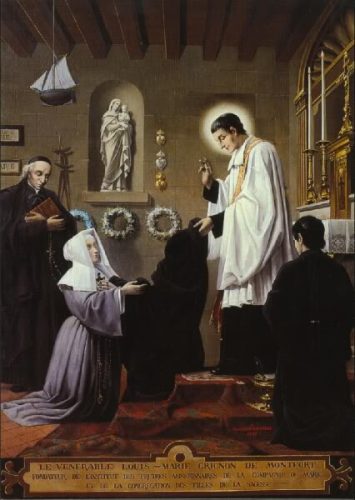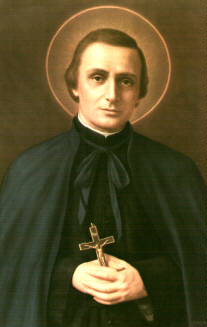On this 28th of April we celebrate two Saints: Saint Peter Chanel (+1841) who evangelized the island of Futuna in the South Pacific – the first to bring the Gospel to a people who had never heard of Christianity. He was tireless and indefatigable in the midst of very difficult and discouraging conditions, and, like many martyrs, was already a saint before he was put to death – recognized so from his humble beginnings in childhood, working as a shepherd from the time he was seven, until his twelfth year. His piety and intelligence were recognized, and he was sent first to school, then to the seminary, before his ordination on July 15, 1827. He was, as expected, an exemplary parish priest.
But his heart was in the missions, to which he had felt called since his youth. Father Peter joined the recently-founded (1816) Society of Mary – the Marists – and was sent to their outposts in the South Pacific islands in 1837. This was well before they were tourist destinations, and to wild jungles and remote shores of Wallis, Tahiti, Tonga, and finally, to Futuna. (In one of those innumerable coincidences of history, this is also the date of the mutiny on the Bounty by Fletcher Christian and fellows in 1789, as France was plunging into revolution. All the mutineers ended up in Tahiti – which had yet to be evangelized, before hiding out on remote Pitcairn Island). Father Chanel’s work and ethic were far different from the mutinous sailors. The good priest was unremitting and relentless in the Lord’s vineyard, always displaying the highest level of self-control, chastity and the other virtues; as one contemporary describes the priest:
Because of his labours he was often burned by the heat of the sun, and famished with hunger, and he would return home wet with perspiration and completely exhausted. Yet he always remained in good spirits, courageous and energetic, as if he were returning from a pleasure jaunt, and this would happen almost every day.
Chanel’s was beloved by the island people, who recognized his own love for them, becoming indeed ‘all things to all men’.
He could never refuse anything to the Futunians, even to those who persecuted him; he always made excuses for them and never rejected them, even though they were often rude and troublesome. He displayed an unparalleled mildness towards everyone on all occasions without exception.
But this charity – as is oft the case – prompted Niuliki, the King of the people of Futuna, to jealousy, when his own son desired baptism. Like many rulers before and since, the king thought that Christianity – more specifically, Christ Himself – would undermine his own authority. So he sent a warrior to do ‘whatever was necessary’, hearkening back to Henry II’s lament of his own archbishop, Thomas a Becket, ‘would no one rid me of this meddlesome priest?”. And like the trio of knights in the 12th century, the pagan ‘warrior’ of the 19th decided that meant putting the priest to a violent end, clubbing him to death with an axe on this day in 1841, after feigning need of medical attention.
Not long before, as the storm clouds gathered around him, Father Peter had calmly declared in prophecy: It does not matter if I die. Christ’s religion is so deeply rooted on this island that it cannot be destroyed by my death
Soon after the martyrdom of the saint, the King’s son did convert, and, as a contemporary eulogy declares: The blood of this martyr benefited, in the first place, the natives of Futuna, for a few years later they were all converted to the faith of Christ
To this day, many regions in the South Pacific are renowned for their Catholic devotion and zeal. By the blood of martyrs…

The other saint we commemorate on this joyful day is Louis de Montfort (1673-1716) known for his own tireless missionary zeal in France, his constant preaching and administration of the sacraments, his founding of two religious orders, the Company of Mary and the Daughters of Wisdom. He is also renowned, perhaps more so for many devout Catholics, for his propagation of true devotion to Mary, the title of one of his numerous works that have stood the test of time, including The Secret of the Rosary and the Secret of Mary.
Father de Montfort’s phenomenal success was the fruit of prayer and sacrifice: He spent much time in solitude in retreat at a cave near Merment, outside La Rochelle. While on active ministry, he was indefatigable, covering many miles by foot, preaching, writing, and went to his eternal reward at the age of 43, worn out like a good and faithful servant, having been a priest for ‘only’ sixteen years, two years more than Father Chanel. But much was by both done in what we might consider little time.
Saint Louis de Montfort predicted that great devotion to the Virgin Mary would be the devotion of the ‘end times’ and the ‘final unleashing of evil’, as the Catechism puts it, that would bring the Bridegroom down from heaven, towards which glorious event we seem to be moving with ever greater speed. In fact, he predicted his writings would be lost, then rediscovered when they were most needed – which was just the case in the 19th century, after which the Popes – Blessed Pius IX being the first – took up his cause.
Father de Montfort most popular devotion advocated making a 33-day consecration to the Mother of God, culminating on one of her major feast days, offering our whole lives to Christ through her, as the most perfect instrument ever to be shaped by the hand of God. He called this devotion a ‘short cut’ to heaven, for Our Lady will perfect all that we do, offering it to her Son and the Father in a way that purifies and elevates our own less-than-perfect intentions and charity. As he puts in his True Devotion to Mary:
by this consecration we give ourselves explicitly to Jesus through Mary’s hands and we include in our consecration the value of all our actions.
This path has benefited countless souls, not least Karol Wojtyla, whose canonization anniversary was yesterday – another coincidence, for as Pope John Paul II, he adopted as his papal motto was ‘Totus tuus’ Montfort’s own words: ‘Totus tuus ego sum, et omnia mea tua sunt‘.
I am all yours (O, Mary), and all that is mine is yours.
Would that we could all say the same.
Pope John Paul II’s Marian thought is perhaps best summed up in his encyclical Redemptoris Mater, of March 25th, 1987, to coincide, approximately, with 2000th anniversary of Our Lady’s birth, preceding the great Jubilee of the Third Millennium.
On this very Marian of days, as we soon begin the month of Mary, Saints Peter and Louis, orate pro nobis…


